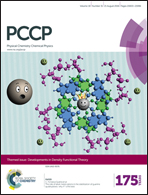The cluster-assembled nanowires based on M12N12 (M = Al and Ga) clusters as potential gas sensors for CO, NO, and NO2 detection
Abstract
The advances in cluster-assembled materials where clusters serve as building blocks have opened new opportunities to develop ever more sensitive gas sensors. Here, using density functional theory calculations, the structural and electronic properties of cluster-assembled nanowires based on M12N12 (M = Al and Ga) clusters and their application as gas sensors have been investigated. Our results show that the nanowires can be produced via the coalescence of stable M12N12 fullerene-like clusters. The M12N12-based nanowires have semiconducting electrical properties with direct energy gaps, and are particularly stable at room temperature for long enough to allow for their characterization and applications. Furthermore, we found that the CO, NO, and NO2 molecules are chemisorbed on the M12N12-based nanowires with reasonable adsorption energies and apparent charge transfer. The electronic properties of the M12N12-based nanowires present dramatic changes after the adsorption of the CO, NO, and NO2 molecules, especially their electric conductivity. However, the adsorption of NO2 on the Al12N12-based nanowire is too strong, indicating an impractical recovery time as NO2 sensors. In addition to this, due to reasonable adsorption energies, apparent charge transfer, change in the electric conductivity, and the short recovery time, the Al12N12-based nanowire should be a good CO and NO sensor with quick response as well as short recovery time, while the Ga12N12-based nanowire should be a promising gas sensor for CO, NO, and NO2 detection.


 Please wait while we load your content...
Please wait while we load your content...